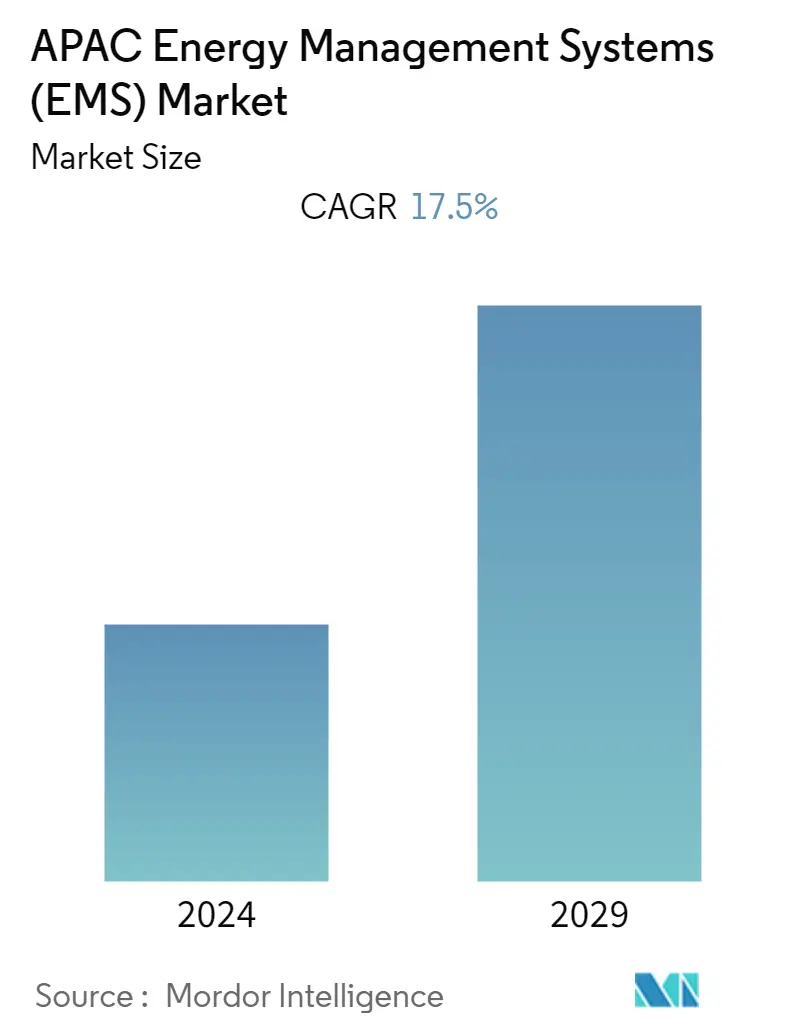Market Size of APAC Energy Management Systems (EMS) Industry

| Study Period | 2019 - 2029 |
| Base Year For Estimation | 2023 |
| Forecast Data Period | 2024 - 2029 |
| Historical Data Period | 2019 - 2022 |
| CAGR | 17.50 % |
| Market Concentration | Medium |
Major Players
*Disclaimer: Major Players sorted in no particular order |
Need a report that reflects how COVID-19 has impacted this market and its growth?
APAC Energy Management Systems Market Analysis
The Asia Pacific Energy Management Systems Market is expected to register a CAGR of 17.5% during the forecast period from 2021 to 2026. Asia-Pacific has been the most rapidly industrializing over the last quarter-century. Energy management requirements and the growing emphasis on reducing utility costs continue to drive the adoption of APAC energy management systems (EMS). The majority of the large buildings in the region are equipped with these systems.
- Proactive measures taken by government organizations in the region for the implementation of standards, such as ISO 50001 (energy-management-system standard) in the building sector, can stimulate the integration of EMS.
- Consequently, more opportunities for automation can now be found across small-to-medium buildings in the region. In the Asia Region, households have grown exponentially over the last two decades. The United Nations expects that urbanization in Asia will reach 64.1% by 2050, further opening up opportunities for the building and construction industry in the region.
- Governments across countries have been actively involved in setting the limits for energy consumption. For instance, structural shifts in the national economy compelled the Government of Vietnam to establish a reduction of energy consumption per unit of GDP ratio as one of the economic targets of the national Sustainable Development Strategy for 2011-2020; as the country remained the most energy-intensive economy in East Asia, behind China, Indonesia, Thailand, Malaysia, and the Philippines.
- NTELS, a Korean tech firm, developed a BEMS where energy data from heating, ventilation, and air conditioning (HVAC) systems were collected. Then, depending on their characteristics, the system identified energy consumption patterns of buildings and created proper energy consumption plans. It also has forecasting and building operations monitoring features, which leads to optimizing energy efficiency in buildings. Such BEMS technology can transform the energy efficiency of the buildings.
- Since the novel coronavirus has been declared a pandemic, most of the businesses and factories are closed or are under severe restrictions. On the other hand, energy consumption in homes, as well as hospitals, has increased drastically. However, the power and energy consumption has decreased overall, mainly due to the halt of manufacturing activity in China, Japan, and India. Nevertheless, relaxation on the restrictions may be apparent in the months ahead. Given the government initiatives to reduce energy consumption, the region will likely provide opportunities over the forecast period.
